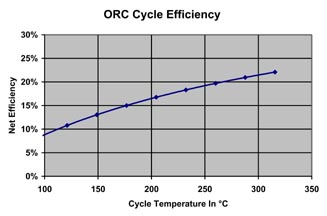An organic Rankine cycle (ORC) is a thermodynamic cycle that uses a carbon-based working fluid to convert energy flowing from a higher temperature heat source to a lower temperature heat sink into useful power. The cycle was first documented by Scottish engineer William Rankine in the 1850s and the cycle begins with the working fluid in a low-pressure liquid state. The working fluid is then passed through a pump which elevates the pressure and sends it to a vaporizer (higher temperature heat source) where it is converted from a liquid into a high-pressure vapor. The high-pressure vapor is then expanded across a power-producing turbine before being converted back into a low-pressure liquid in a condenser (low-temperature heat sink). The steam Rankine cycle is well developed and utilized worldwide and it differs from the organic Rankine cycle because the working fluid is water rather than a carbon-based compound. And in addition to the basic Rankine cycle, more sophisticated variants have been developed including superheated, recuperated, and supercritical cycles which increase efficiency and therefore power output.
 ORC Cycle Efficiency Graph – Click To View |
As a first-order estimator, this chart depicts the thermal efficiency a cycle may produce given a heat source temperature and assuming the heat sink is 60°F/16°C ambient air. Another way to view a Rankine cycle is that you capture heat through a vaporizer and then reject 80-90 percent of that heat through a condenser and the difference, 10-20 percent, can be converted into useful power.
Although steam cycles are the most widely used by a large margin, organic Rankine cycles are attractive because hydrocarbon or other carbon-based working fluids can be vaporized at lower temperatures enabling power to be produced from lower temperature geothermal, solar, and industrial waste heat sources. Additionally, ORCs eliminate the need for full-time plant operators because they operate at lower pressures and do not need water chemistry maintenance. However, working fluid cost, decomposition, temperature limits are an organic Rankine cycle’s primary disadvantages.
Barber-Nichols (BN) has been involved with organic Rankine cycle technology since 1966 and ORC-powered automobiles were an early application. Bill Lear of Lear Jet fame was an early customer and the hardware developed on that project was later used to set the land speed record for a steam-powered car at the Bonneville Salt Flats. In the late 1970s and early 1980s, BN was involved in many ORC projects primarily involving solar and geothermal power. Notable projects included solar engine-driven air conditioners for the Los Alamos Library and Honeywell International’s Headquarters. Geothermal projects included megawatt-class baseload plants that are still in operation today and solar projects included solar-powered irrigation water pumps, dish-mounted solar engines, and solar cooling of industrial buildings. Over the years, BN has consulted, designed, and produced ORC turbines and systems ranging from 15 kW to 6 MW and for technology demonstrators to commercial installations that have been operating for more than 25 years.
Barber-Nichols has the infrastructure to support the sale, installation, and maintenance of Rankine Cycles in North America only.



